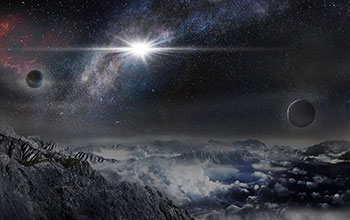Multimedia Gallery
Record-breaking, superluminous supernova ASASSN-15lh
An artist's impression of the record-breaking, powerful, superluminous supernova ASASSN-15lh as it would appear from an exoplanet located about 10,000 light-years away in the host galaxy of the supernova.
More about this image
Astronomers have witnessed a cosmic explosion about 200 times more powerful than a typical supernova -- an event that already ranks among the mightiest outbursts in the universe -- and more than twice as luminous as the previous record-holding supernova.
At its peak intensity, the explosion, called ASASSN-15lh, shone with 570 billion times the luminosity of the sun -- a luminosity level approximately 20 times the entire output of the 100 billion stars comprising our Milky Way galaxy.
The record-breaking blast is believed to be an example of a "superluminous supernova," a recently discovered and very rare variety of explosion unleashed by certain stars when they die. Scientists are unsure of what sorts of stars and stellar scenarios might be responsible for these extreme supernovae.
At around 3.8 billion light-years away, ASASSN-15lh is among the closest superluminous supernovae ever observed. Given its uncanny brightness and closeness, ASASSN-15lh may offer key clues in unlocking the secrets of this baffling class of celestial detonations.
"ASASSN-15lh is the most powerful supernova discovered in human history," says Subo Dong, an astronomer and a Youth Qianren Research Professor at the Kavli Institute for Astronomy and Astrophysics at Peking University and lead author of a recent study published on ASASSN-15lh. "The explosion's mechanism and power source remain shrouded in mystery because all known theories meet serious challenges in explaining the immense amount of energy ASASSN-15lh has radiated."
ASASSN-15lh was first glimpsed in June 2015 by twin telescopes with 14-centimeter-diameter lenses in Cerro Tololo, Chile, while conducting the All Sky Automated Survey for SuperNovae (ASAS-SN), an international collaboration headquartered at The Ohio State University (OSU). These two tiny telescopes sweep the skies to detect suddenly appearing objects like ASASSN-15lh that are intrinsically very bright, but too far away for human observers to notice. ASAS-SN is supported by the National Science Foundation (NSF) (under grant AST 15-15927). The co-author of the study published on ASASSN-15lh, John Beacon of OSU, is supported by an NSF Faculty Early Career Development (CAREER) program award (grant PHY 14-04311).
To learn more, see the Kavli Institute news story Record-shattering cosmic blast could kelp crack the case of extreme supernova explosions. (Date image taken: December 2015; date originally posted to NSF Multimedia Gallery: March 7, 2016)
Credit: Jin Ma, Beijing Planetarium
See other images like this on your iPhone or iPad download NSF Science Zone on the Apple App Store.
Images and other media in the National Science Foundation Multimedia Gallery are available for use in print and electronic material by NSF employees, members of the media, university staff, teachers and the general public. All media in the gallery are intended for personal, educational and nonprofit/non-commercial use only.
Images credited to the National Science Foundation, a federal agency, are in the public domain. The images were created by employees of the United States Government as part of their official duties or prepared by contractors as "works for hire" for NSF. You may freely use NSF-credited images and, at your discretion, credit NSF with a "Courtesy: National Science Foundation" notation.
Additional information about general usage can be found in Conditions.
Also Available:
Download the high-resolution JPG version of the image. (517.9 KB)
Use your mouse to right-click (Mac users may need to Ctrl-click) the link above and choose the option that will save the file or target to your computer.

